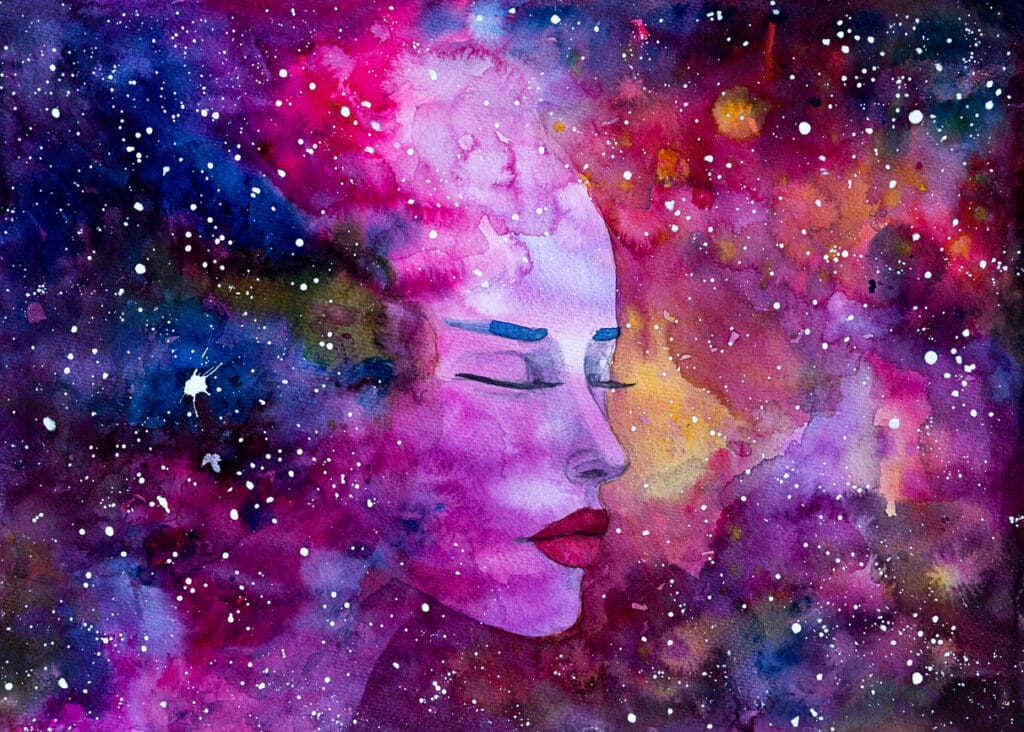
Humans spend at least two hours a night dreaming. That’s more than seven hundred hours a year, and six years spent dreaming in a lifetime. While we all have our own struggles and patterns of successful sleep, dreams are a unifying factor of humanity. Whether you’re riding the subway to work, standing in line for a coffee, or taking a walk in your neighborhood, odds are you cross paths with someone who sleeps (and dreams) just like you do.
Indigenous communities, ancient cultures, and world religions have studied dreams throughout history. Their approaches have sought to answer similar questions: What can we learn from the images and symbols encountered in our dreams? What lessons can we take with us from sleep to our waking life? Such questions, and years of personal spiritual exploration, drew Varela grantee Gabriela Torres Platas to the practice of Tibetan Dream Yoga (TDY). TDY is a technique Buddhist traditions have cultivated to induce, enhance, and refine lucid dreaming—the ability to understand that one is dreaming amid a dream—to extend the benefits of contemplative practices during sleep into waking life. Gabriela’s recently funded project aims to investigate the practices, benefits, and neural correlates of TDY, and provide foundational research to explore future applications of the practice.
According to Buddhist legend, following enlightenment, Siddhartha rose from his practice to share that he had awoken, thus leading to the title Buddha (budh in Sanskrit means “awakened”). As a spiritual and cultural tradition, Tibetan Buddhism has always had ties to literal and figurative sleep, aiming to help practitioners awaken from ignorance and embrace the true nature of reality. Dreaming may be an optimal state for working with one’s fixed cognitive habits and assumptions about life, and TDY offers specific techniques to do just that.
Diving into TDY a few years ago started as a personal journey for Gabriela, who spent her childhood in Mexico and studied biology as an undergraduate. She’d always been curious about the nature of reality, and it wasn’t until exploring Dream Yoga that she saw a path of inquiry blending her spiritual practice and her career in research. After finishing her PhD at McGill University investigating how inflammatory pathways in the brain contribute to depression and suicide, she opted to step away from the microscope. She wanted to see how contemplative practice could help change people’s lives like it had her own.
Now, with the Paller Lab at Northwestern University, she’ll build from existing relationships with monks and monasteries in India and across the globe to dive deeper into the mechanisms and benefits of TDY. “This Varela project is really an attempt to merge [science and contemplative practice]—trying to find the science behind Dream Yoga, while also better understanding the spiritual and cultural context,” says Gabriela.
“This Varela project is really an attempt to merge
[science and contemplative practice]—trying to find the science behind Dream Yoga,
while also better understanding the spiritual and cultural context.”
TDY takes shape in practices performed in waking life that prime the practitioner to become aware of the transitory nature of reality. In sleep, TDY begins with lucid dreaming. Lucidity makes the mind more flexible and allows for a cultivation of habits during the dream. Once in a lucid dream, things like time and speed can be transformed and objects can change with intention (like a chair becoming a dog). Practicing this flexibility in dreams then helps emotional states be transformed in waking life. “The idea is that when you do this in your dream and you’re lucid, that flexibility comes into your life as well, so then you’re able to detach from any conditioned reactions that you have,” says Gabriela.
While neuroscientists have studied the neural correlates of lucid dreaming states and found real-time dialogue between experimenters and dreamers possible, no one has yet investigated TDY in the brain. Gabriela aims to bring recent neuroscientific advances to the study of this complex practice. Monitoring experienced TDY practitioners with electroencephalogram (EEG), performing post-sleep dream reports, and testing real-time two-way communication between researchers and dreamers will paint a clearer picture of what’s happening in the brain during TDY.
Beyond the brain, there’s more to learn about the cultural elements of the practice. By collaborating with Tibetan scholars Michael Sheehy and David Germano of the University of Virginia to host in depth interviews with experienced practitioners, this project will also provide a comprehensive, multidisciplinary study of the characterization and historical context of TDY. But few Tibetan Buddhist monks even learn the practice, which makes it hard to find study participants. In her experience, even monastics who practice TDY don’t really talk about it.
Finding participants for her research may take time, but Gabriela is hopeful that in the future this work will be foundational for helping those struggling with disturbed cognition, emotions, or behavior. “Not only does Dream Yoga help you be present in every moment,” she says, “but it also detaches you from objects, feelings, situations, and conditioned reactions. It creates this larger space between your inside world and the outside world.”
For Gabriela, this project is only the beginning of a longer journey. She already wonders how the possibility of sharing TDY with a larger audience might help change lives. “I can see how Dream Yoga can be used as a potential tool to help alleviate mental health issues,” she says. “We are still very far from that, and many experiments and trials have to be conducted to assess its feasibility, viability and negative effects, but this project is a start.”

